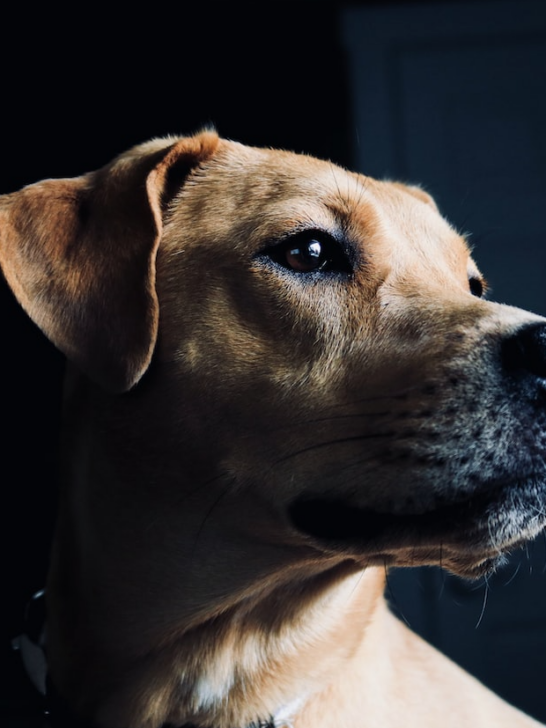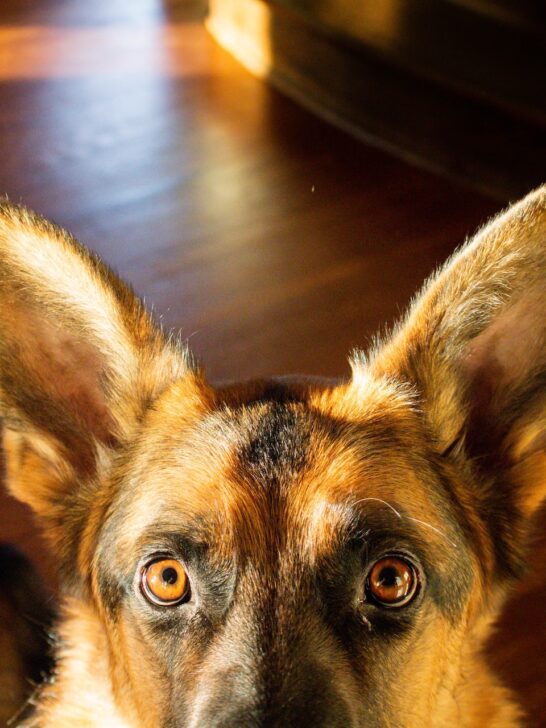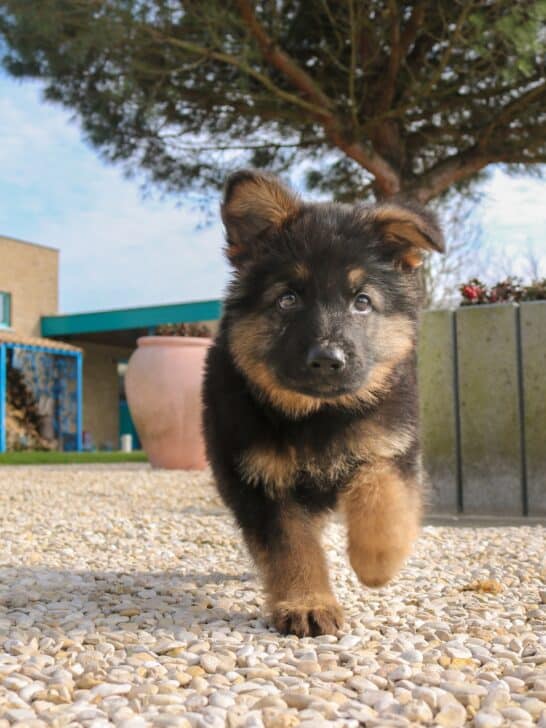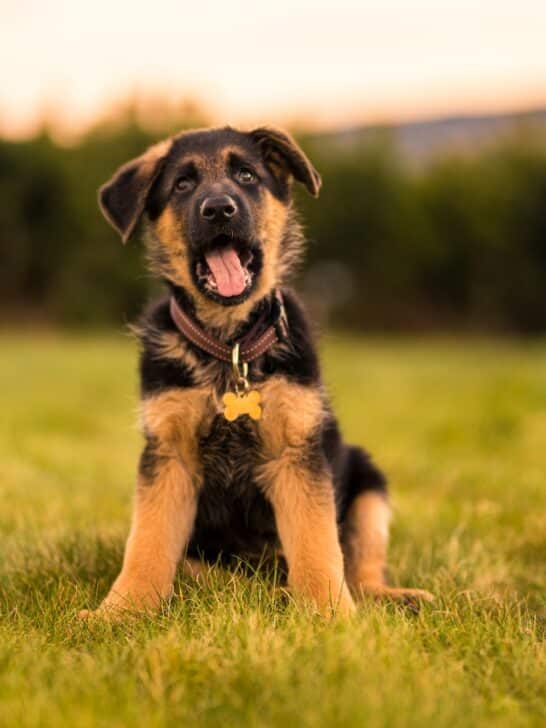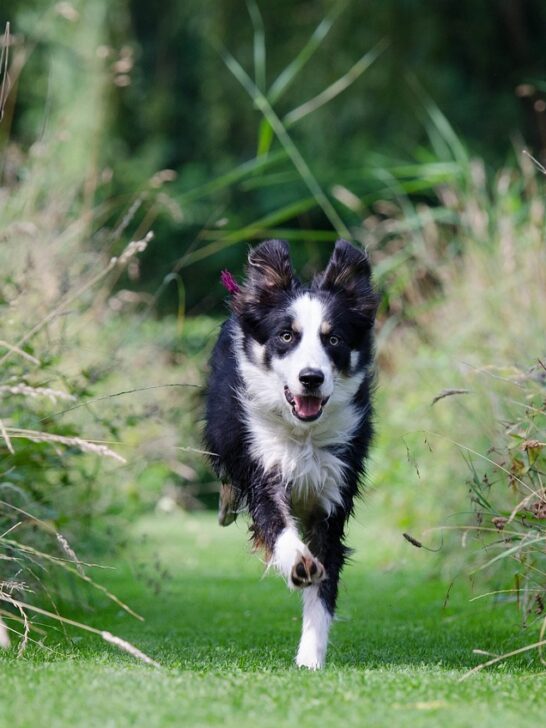How to Perfectly Train Your 8 Week Old German Shepherd Puppy: The Ultimate Guide for Beginners
So.. you’ve just welcomed an absolutely adorable bundle of joy into your home and family – congratulations!
Having a dog is an absolute joy, and German Shepherds especially can be a real treat to raise, since they’re a super smart and sociable breed.
It can be daunting to consider training a puppy at first, especially if you have little or no experience in working with man’s best friend.
Not to worry – once you’re done reading our concise yet comprehensive guide, you should know exactly what to do and feel prepared, even confident about the task at hand.
Covering all bases on how to train your new addition starting from when they are eight weeks old and carrying you through their first year or more, this is the only tab you’ll need to open on the matter.
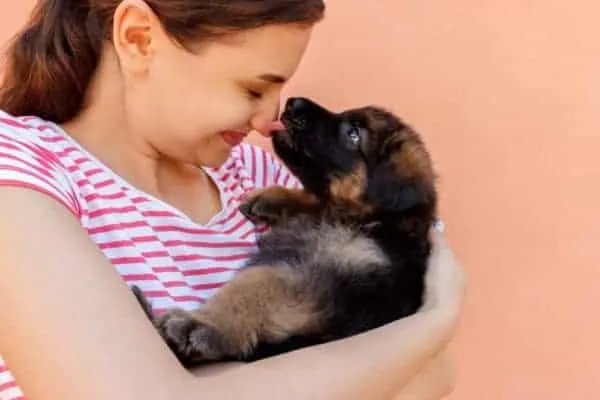
Getting Started: Things To Bear In Mind When Training An 8 Week Old German Shepherd Puppy
Just before we begin, here are a few quick notes to keep in your head as you embark on this journey, which should help at least a little in ensuring you stay on the right track.
Begin as Soon as Possible
As explained by the official German Shepherd Dog Club of America, the first few months are crucial in establishing core concepts for training.
In creating a good foundational knowledge for them to build on, you should prepare them for a lifetime of good behavior and a strong, loving bond.
Likewise, according to the American Kennel Club, German Shepherds are some of the smartest pups around, so you might find they pick up on these new skills quicker than you anticipated.
When you first bring your pup home, you might be tempted to spend the first few days or even weeks getting to know them all day every day, setting up Instagram photoshoots and the like.
Whilst you’re more than welcome to do so, it is important you devote some of that time to training and exercise as well.
Puppies are a little like kids, in that they absorb everything around them and soak up information with ridiculous ease.
According to a scientific study conducted by Claudia Fugazza in 2018, published in Scientific Reports journal, “social learning skills are present in 8-week old puppies”.
Those they tested learned how to open a puzzle box filled with food and demonstrated they could retain this information for at least an hour.
Their research concluded that “dogs as young as 8 weeks old have already developed some social learning skills,” demonstrating their ability to learn and consistently recall what they discovered.
Starting as soon as possible is well worth it!
Train Every Day
As with anything in life, for humans and canine companions alike, the key to success in training is consistency, people!
Even on the days that you don’t feel like it, although obviously not to the point where it is detrimental to your health!
There’s not much more to it than that – sticking to a couple of short sessions daily will really help your young German Shepherd puppy pick everything up.
Stick to the Basics
It can be incredibly overwhelming when you first start puppy training.
Simply Googling phrases about it can bring up millions of results – but hey, you’ve found this guide!
You will need to dedicate a lot of effort and energy to training; there’s no denying that new puppies are just as much a handful as a toddler.
However, there are just a few specific areas you ought to focus your attention on, some generalized to all puppies and others more directly related to German Shepherds.
After all, puppies are largely alike, but their breed can somewhat indicate what behaviors to expect, as well as what you might focus on.
In this guide, we’ll be going through the following six central ideas when it comes to training a puppy:
- Toilet training
- Human and animal socialization
- Crate training
- Basic commands
- Leash training
- Avoiding undesirable behaviors
So. you’re equipped with three basics that are worth repeating to yourself throughout the training process. Let’s get started!
What To Focus On When Puppy Training A German Shepherd
Focus One: Toilet Training
As one of the most pressingly important things to teach your dog – unless you like the idea of urine and feces covering your house! – it makes sense to start here, right?
There are no taking chances with a puppy: leave the room for even a moment and you might come back to a mess, however accidental.
For the first month or two of having your puppy at home, it is crucial that you have a more or less constant eye on what they’re up to, unless you’ve provided them a secure area with a training pad and know that they are likely to use it.
Concentrate on the basics: teaching your pup where it is okay to do their business and establishing a routine for the appropriate times to do so.
At first, they won’t be able to hold in their waste for longer than a few hours, as much like a baby, they don’t yet possess the muscle strength and control needed to hold it in – this isn’t them misbehaving.
Puppies are a big commitment!
Unfortunately, they can’t wear diapers either, so it’s important to give them several opportunities to go outside and relieve themselves.
Use treats as a positive reinforcement when they do so in an appropriate place.
Each time you take them to the right spot, say “go to the bathroom” or whatever phrase you’d like to use – it might feel silly at first, but eventually they’ll start to associate that phrase with going potty.
You’ll find they naturally want to pee around the same time you do: in the morning, after meals or drinks, and before going to bed.
Below is a basic schedule for puppy potty training.
They will gradually need to go out less as time goes on, so don’t be alarmed about how much time you’re going to be spending watching them go to the bathroom for the first few weeks:
If you’re using indoor potty pads for whatever reason, it might help to take them to the pad at these times as they might not yet associate the feeling of a full bladder with needing to pee.
Puppy Potty Training Timeframe
| Early morning – 6 AM – 7 AM | Your pup will probably need to pee as soon as they wake up! |
| After breakfast – 8 AM – 9 AM | Even if it’s not quite time to pee again, eating stimulates the bowels, so it’s possible there will be a number two now |
| Lunchtime – 11 PM – 12 PM | Remember, puppies should go out every two hours or so, as this is about the limit for an eight week old’s bladder! |
| Mid afternoon – 2 PM – 3 PM | As above – yes, it might feel a little tedious, but you signed up to this commitment when you got a puppy |
| Before/after dinner – 5 PM – 6 PM | If they don’t go before, take them after, but even if they have been it’s possible they’ll want to a second time |
| Pre-bedtime – 8 PM – 9PM | Even if you’re staying up, you should encourage your pup to go to the bathroom one last time and then direct them towards bed for the evening |
| Middle of the night | Unless you’re leaving puppy pads out and feel confident they will get used, then you’ll want to get up and take your pup out – bear in mind that if you’re crate training overnight, most dogs won’t want to go to the bathroom in a confined space, which will result in an accident somewhere it shouldn’t happen, like all over a blanket |
| Following a long nap | Perhaps not always, but more often than not, your pup will want to go and at least stretch their legs outside, but they’ll probably go and pee as well |
Expect a few accidents at first and avoid scolding them harshly, if at all. It really isn’t their fault and they’ll learn to fear going to the bathroom as a direct result, which really won’t help the situation.
Push on with the same routine, providing them a safe spot in an area where they can be away from other dogs if they need to.
Puppies, especially young ones, may be frightened to go to the bathroom around older pooches, especially bigger ones.
You will also notice that eventually, your dog gives certain cues or behaviors to indicate they need the bathroom, like standing by or barking at the nearest door that leads there.
It’s possible they might try to do this when they don’t need the bathroom as well, but once they eventually realize you’ll bring them straight back inside after a couple of minutes, this will stop.
Remember – you should always reward your pup when they successfully go in the right place, rather than yelling or acting aggressively when they don’t.
This is the best way to ensure they will pay attention to what it is you want them to do.
If you find they’re going more than seems natural or having several accidents a day after more than four to six months of trying to train, it might be worth consulting a vet to make sure everything is okay physically.
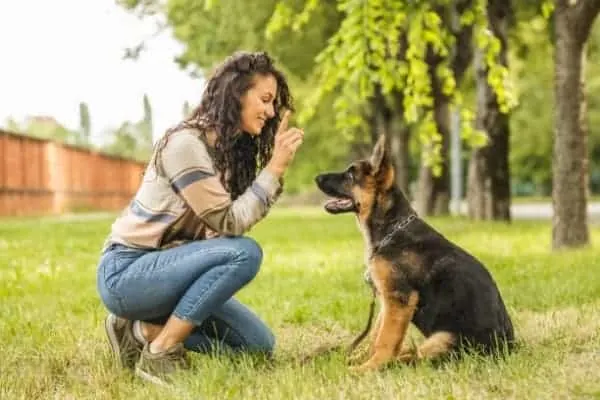
Focus Two: Human and Animal Socialization
It’s likely there are plenty of people queuing to meet your new puppy, as well as a whole host of animal friends to get to know.
Add to this potential for seeing furry friends and their humans whilst you’re out on walks and it’s especially important to focus on how to behave around them as soon as possible.
Every day your puppy is exposed to new sights, smells, sights, sounds and sometimes even tastes if you turn your back for long enough.
You need to keep them reassured that everything is okay and remove them from anything that appears to be overstimulating.
The primary concern here is to make sure your dog feels safe and secure, and that the experience will be positive as much as you can anticipate.
German Shepherds have a tendency to be wary of strangers, whether they’re dogs or people, and can go into guard dog mode pretty quickly if they feel threatened.
Therefore, they might be a little aloof and resistant the first few times you interact with somebody.
This means checking that those you are introducing to the puppy know how to properly handle and treat one, especially any children who happen to be around.
Likewise, you should also ask in advance whether any animals you might come into contact with have proven they are able to stay relatively calm and behave appropriately when spending time with other dogs.
When it comes to spontaneous street interactions, you should try and work out if the other dog and human are friendly, bearing in mind anything you know about your pup and any time they have spent with animals and people before.
If your pup seems fearful or the other dog is off leash and not being controlled, immediately leave the situation and don’t worry about being apologetic.
Other owners are not your concern, the safety and welfare of your dog is.
Things To Remember When You Socialize Your German Shepherd Puppy:
- Vaccinations: Puppies are highly susceptible to disease prior to having their jabs, so it’s important to limit interactions with humans and other animals as much as possible until all of them have been administered
- Positivity: Be happy and excited and keep a relaxed tone when talking to the pup, as this will encourage them that everything is okay and there is nothing to worry about
- Treats: Reward every successful interaction with a delicious snack for a job well done, ensuring they associate meeting new friends as a good thing that gets them something yummy after
- Noise: It can be tempting to squeal or shout when you spend time with an adorable puppy, but if they get freaked out or upset it might cause an accident or lead to misbehavior – ask that everyone stays calm and screams on the inside!
- Adventure: Go to new places and check out new things! Every time your pup does something they’ve never done before, they gain new experiences that contribute to their understanding of the world – make sure everything is safe and that they aren’t exposed to bacteria from infectious diseases before being vaccinated!
Focus Three: Crate training
If you’re not inclined to use a crate, that’s fine, you’re more than welcome to skip this section.
But don’t be fooled by scaremongering online – it’s not a cruel thing to do, and can actually be very beneficial for your German Shepherd puppy.
It’s especially useful for the times when they need to be in the crate for travelling, like going to the vets for instance.
Likewise, as long as they have enough room to fully stand, sit completely upright and lie down comfortably with their legs outstretched, most dogs quite like being in a crate.
It offers them a safe, comfortable, private space to relax if stressed or have some alone time. Like us humans, your pup might just want to hang out by themselves for a bit!
Worried about accidentally doing something neglectful, or just stressed about crate training in general?
Here are some tips to follow that should help you succeed and keep your German Shepherd happy at all times.
- Leave the door open at first: we’re just talking the first, second and possibly even third time here, depending on how anxious your puppy is, but this should keep them from getting anxious – knowing they can leave at any time will be a great help. Gradually begin closing it, just for a few seconds and then longer, increasing the amount of time they spend in the crate little by little.
- Give treats while inside: not while they’re crying or upset, obviously, as this encourages them to whine for treats! However, whilst they still seem calm, offering up a little snack – potentially even a meal – inside the crate will create positive associations with spending time in there.
- Don’t give in to crying: this is very different to extreme distress or upset – if you think your dog could hurt themselves or is very freaked out, let them out ASAP and give them some reassurance. However, if they whine a little when you first put them in, try and wait until they have been settled a bit before letting them out again, as otherwise it will result in an association with crying and getting what they want
- Keep the crate in the same place: try not to relocate it if you can, as this will be confusing for your pup when their surroundings change and/or discourage them from going there when they need time alone
- Ensure it is temperate: avoid any drafts and don’t place the crate anywhere that will be exposed to direct sunlight
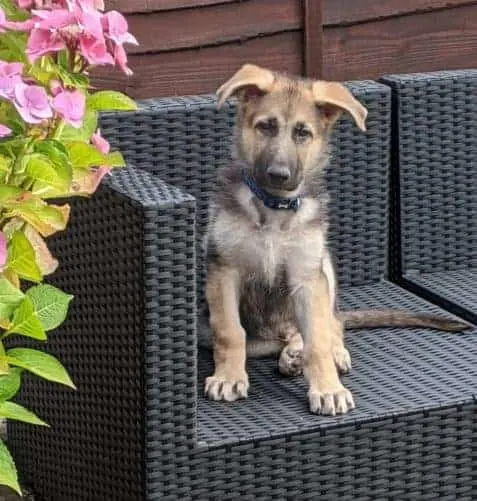
Focus Four: Basic Commands
As we’ve already discussed, not only are puppies very quick learners that are able to pick up new skills as early as eight weeks, German Shepherds are also a particularly clever breed in general.
You can start teaching them some basic commands like sit, stay, lie down, and shake as soon as they come home!
Although every dog is different, the basic tenets of training are pretty straightforward, and as long as you follow them to the letter, you shouldn’t have any trouble succeeding after a few weeks or months of training.
- Use your voice: it is, after all, your primary method of communication. You might be surprised to learn that tone is more important than what you say until those certain words and their meanings have been learned and understood. When giving commands, use a neutral, authoritative tone; save the high pitched cooing for tummy rubs.
- Work on several skills at once, but separately: your pup will get sick of practicing the same thing day in, day out, so switch up the commands everyday or every other day if they’re not getting the hang of something.
- Change locations: as long as it’s somewhere quiet and away from other animals, distractions are fine – this will teach them to stay on task and obey you when stimulus presents itself, because it absolutely will when you’re out on a walk or in public!
- Make sure to reward: only when they successfully perform the command, of course; when they succeed in getting it right, you’re ready to break out the treats. Don’t just give out food though – praise and affection are just as motivating as snacks!
- Keep it short and sweet: a couple of minutes at a time, every once in a while or at least once a day, will be far more effective and rewarding than an hour straight of saying the same word over and over to no reaction.
- Finish positively: always try to finish with a command that your dog knows and has successfully completed a few times, as this will ensure they end on a treat and remain positive about the possibility of more training in the future.
You can also find step by step guides on how to teach particular commands if you’re having trouble working out a method for yourself.
There’s no shame in consulting YouTube for a visual tutorial or just making a quick search for the trick in question.
Focus Five: Leash Training
When your dog is all vaccinated and ready for walks, they should be prepared!
This means that the best way to get ready for this is to practice with the leash and harness at home, so they don’t get freaked out by wearing it or being slightly restricted.
You’ll notice we said harness there – this is much safer for puppies generally, as they have more of a tendency to pull and could strain or injure themselves when you’re out and about.
Ensure that the harness you opt for fits properly and isn’t digging into your pup’s skin or rubbing anywhere.
You’ll likely have to get a new one relatively soon, unless you opt for an adjustable one, but even then German Shepherds grow quite quickly.
Initially you should show your puppy the harness and leash – allow them to smell both items, place them in the area or on their backs and give them a treat, so they learn to associate their presence as a good thing.
Then consider popping the harness on for a minute or two to see how they react – if they get upset, remove it and try again another time.
Otherwise, offer them a treat and some praise for the successful time spent leashed and harnessed.
Next, put the harness and leash on and have your pup wear it for a while – either play for a little bit whilst it drags behind them, or maybe go for a little “walk” around the house.
This will allow them to get used to the sensation of being controlled whilst still inside and feeling safe.
If you have a garden, try a small stroll around, allowing them to wander around whilst you’re holding on to the leash.
Practice recall by calling their name and holding up a bag of treats, possibly adding in a vocal “come here” or “come back” – maybe even just “come” to keep it really simple.
Every time they return to you, they get a treat!
For more information on this subject: The Best Ways to Leash Train Your German Shepherd Puppy

Focus Six: Avoiding Undesirable Behaviors
You might not realize this, but a puppy’s teeth and claws are razor sharp and can do some serious damage!
They don’t realize quite how strong they are at first, so it’s important to teach them that nipping, chomping, or jumping up and scratching at you is not appropriate – unless you like being covered in cuts and bruises.
How to discourage your German Shepherd puppy from biting, scratching and jumping up
- If they bite, jump up or scratch you and it hurts, even if it only hurts a little – but it probably stings quite a bit! – then be sure to react with a sad, hurt or shocked expression and say “ouch” in a hurt tone. There’s no need to yelp like a dog!
- Only ever have playtime when toys are involved – encouraging them to roughhouse with just your hands will just encourage them to lunge at you and not their toys, so have a few puppy safe chewables on hand at all times
- Try not to jerk away or jump back too quickly, if you can avoid it – stay still and move away slowly as otherwise your pup might think you’re playing and bite down harder or chase you
- Leave the area where you’re playing or place them in a different spot for a few minutes then return or allow them to return once they have calmed down
- Never allow your puppy to bite, play with or chew on your hair, clothes, face, feet or shoes – leave calmly and return when they have stopped being so excitable
- Avoid screaming and yelling at or otherwise punishing your puppy for biting you – simply say no in an authoritative tone and make sure you stop playing until they are calm again, to prevent further aggression or anxiety
Top Tips For Success When Training Your German Shepherd Puppy
1. Don’t overdo it
We’ve covered this already but it bears repeating: little and often is the best with puppy training, as well as keeping things relatively simple.
Stick to the most basic of commands and only do a couple at a time, though never all at once.
You might want to try and use one word commands like “come” for recall and “down” for lying down, to give a few examples.
The simpler the request, the quicker and easier it will be for your dog to understand it.
2. Find a quiet space (at first)
In order to actually learn, your dog needs to be able to hear what you’re saying and pay attention to you while you’re speaking.
At first, go somewhere with few or no distractions to train, then gradually introduce new stimuli over time, though nothing too loud.
It’s best to train one on one or perhaps with one other person to help, as too many people speaking orders at them will become stressful quite quickly, causing them to lose interest and attempt to go elsewhere or get upset.
3. Recognize your dog’s signals and expressions
As very intuitive and emotional creatures, your German Shepherd will give you many indications of how they’re feeling and whether they’re actually paying attention to you.
By making a point of keeping a close eye out early on, you’ll find it much easier to pick up on these signals, then avoid any issues in the future.
Stress signals like shaking, constantly licking or smacking their lips, cowering away or turning their back to you suggests something is the matter.
Ignore anything you’ve heard about “becoming the alpha” or asserting dominance over your dog as “leader of the pack”.
This is harmful, old-school dog training that can cause fear or anxiety that actually damages your dog’s psyche.
Stop whatever it is you’re doing that seems to be causing them upset, or leave wherever you’ve gone that has resulted in this behavior.
They shouldn’t be disciplined for being scared or anxious in the same way humans shouldn’t either.
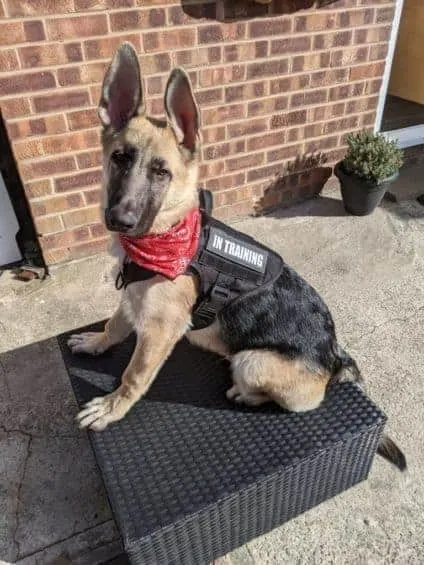
4. Stay positive – avoid negative reinforcement
This doesn’t mean letting your puppy wreak havoc – you can always remove them from a situation when they are misbehaving, or leave the space yourself until they calm down.
Crates can be very useful in this situation!
Whether it’s using a calm, neutral voice, praising and giving treats, focusing on all of the good things and successes you’re having or hyping up the little things, all of this positivity will only contribute to good behavior.
Don’t ever resort to yelling, screaming or shouting at your puppy – even talking to them sternly isn’t advised!
They’re not going to listen just because you raised your voice several decibels.
In fact, it’s more likely they’ll end up scared of you, and if they do perform the command, that’s only because you’ve frightened them.
Making your dog anxious will throw a spanner in the works and prevent successful training.
So no matter how frustrated or angry you get, do not take this aggression out on the innocent dog who isn’t acting purposefully.
5. Utilize redirections
Again, if your puppy starts doing something you don’t like or want to discourage, instead of resorting to yelling, just distract them! Trying to chew on something they shouldn’t?
Get an appropriate toy and play tug of war! Scratching or digging at something they shouldn’t?
Call them over to you – even if it means pretending you have a treat that’s not coming, though don’t do this too often if you can avoid it.
6. Be consistent
This doesn’t just mean train every day, although as already covered, making sure to save two to five minutes a day for some rehearsal is also important to your success.
You should also use the same words for commands, and ask others to do so as well. Too many variants of the same command will only be confusing, so keep it simple and advise everyone of what to say.
A couple of short daily sessions will serve you much better than an hour a week, as well as give your pup plenty of time for snoozing, eating, playing and, of course, getting lots of fuss, attention and cuddles.
7. Consider mental training – not just physical
Yes, getting enough exercise, learning commands and being taught how to walk appropriately is important, but your clever and capable German Shepherd needs to do some brain training as well.
There are plenty of toys that encourage your dog to work out a variety of puzzles to be rewarded with a treat, stimulating their mind and allowing for a cognitive workout.
You can also find plenty of brain training games to try online if you’ve got more time on your hands.
If you’re really dedicated to giving your dog the best, there’s even brain training courses that not only eliminate bad behaviors but also encourage your pup to be more obedient and take advantage of those brainy genetics!
8. Make it fun
Much like with little kids, there are plenty of games you can play with your dogs that are both highly enjoyable for all involved, but also teach your dog skills and encourage good behavior…covertly.
It’s training, without your dog getting bored and giving up halfway through – and you’ll also increase that beautiful bond you’re working on, as well.
Check out these suggestions from the American Kennel Club for inspiration – you could even make up your own!
9. Don’t forget handling!
Though you’ll be doing this anyway just by interacting with your German Shepherd, it’s important to teach puppies the proper way to behave when they are being handled, for instance by a vet for their vaccinations or a groomer when they take their first visit.
Work on very gently touching the pup’s nails, paws, nails, legs and nose – all especially sensitive areas they will need to get used to as touching them will be required.
If they move away from you or react negatively, then stop and try again in the future, but some dogs just don’t like being touched in certain places for whatever reason.
By giving them gentle pets in these places, you’re preparing them for the uneasiness of being touched there in future.
This is especially important for German Shepherds, as remember, they are especially wary of strangers.
10. Have patience and stick it out
It can be disheartening work at first, but training a puppy is one of the most rewarding, satisfying experiences you can have when you get it right.
It secures your bond, enables you to have a whole lot of fun and avoids them developing negative characteristics like aggression, fear of strangers or other animals, or running off in public.
Remember, it only takes a few minutes a day to get there, in keeping with your German Shepherd’s admittedly impressive but still relatively short attention span.
The more you follow the advice laid out in this guide and continue the same hard work, the better your German Shepherd will respond to you.
Check out this video for more great advice!
Need more support? Additional help and guidance
When you’re finding it difficult to successfully train your puppy, don’t give up! There are steps you can take to make things a little easier or give you and your German Shepherd a helping hand.
It might not be that they are stubborn or disobedient – though if it does prove they’re being naughty, we’ve got solutions there too.
First of all, take a breath and think about it – has it really been a considerable amount of time since you started working with your pup?
For instance, toilet training requires at least four to six months of training on average for a puppy to completely stop having accidents altogether.
Of course, this doesn’t mean you should put up with aggressive behavior, or ignore any signs that something might be wrong.
Overexcited dogs can be calmed down in time, but a serious issue with anger needs to be addressed by a professional.
Many have found that Your German Shepherd Puppy Month by Month, 2nd Edition by Liz Palika is an incredible resource when it comes to training their pups, so it’s well worth checking this out for a detailed play-by-play of what to expect, and a timeline of achievements and estimates to follow along with.
If your dog is otherwise loving and calm, but has a tendency to misbehave, it could be that they aren’t getting enough exercise, leaving them overstimulated and full of pent up energy.
Of course, puppies will only require a little bit of energetic play per day, and a small five to ten minute walk, but the older they get, the further a distance they’ll be able to go.
A general rule is to allow for five minutes of exercise for each month they are old, so a six month old puppy can do around half an hour of continuous walking in total.
Make sure that if you’re leaving them at home unsupervised, they have been given the opportunity to use the bathroom, are in a safe area where they are unable to hurt themselves – whether crated or otherwise – and have had enough exercise and plenty of love and cuddles before you go.
This should help avoid any destructive behavior, acting out, accidents or other puppy shenanigans – you may even want to give them a puzzle-based treat like a Kong filled with peanut butter or something more intelligent, to serve as a distraction when you make your exit.
Remember, attempts to reprimand or redirect by punishing or shouting will either serve as giving your dog the attention they want, or make them anxious and eventually scared of you.
This could even cause them to develop aggressive tendencies.
Prioritize directing them to a new activity and praising them for being suitably distracted – this is the only way in which you’re going have much success with training outside of the short term.
There is no shame in seeking the assistance of a puppy training school or dog expert if you find yourself at a loss for what to do – we all need a little help sometimes and certain dogs can have their misbehavior explained.















